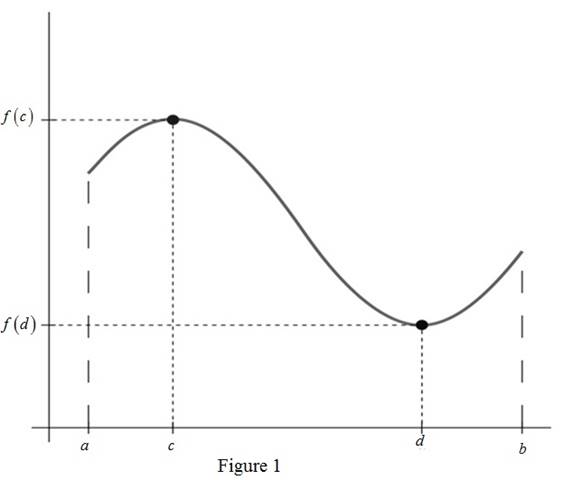
Concept explainers
(a)
To explain: The Extreme value theorem.
(a)
Explanation of Solution
The extreme value theorem is stated as follow.
Extreme Value Theorem:
“If f is a continuous function on
From the following Figure 1, the meaning of extreme value theorem can be easily understood.

In the Figure 1 the function f is defined on a closed interval
(b)
To explain: The working of Closed interval method.
(b)
Explanation of Solution
Closed interval method is an algorithm that is used to find the absolute minimum and the absolute maximum of a function over a closed interval
It consists of following three steps.
Step 1: Find the values of function f at the critical points in
Step 2: Find the values of function f at the end points of the interval
Step 3: Largest of the values from step 1 and step 2 is the absolute maximum value and lowest one is absolute minimum value.
Apply the closed interval method to find the absolute maximum and minimum of a function as illustrated in following example.
Example:
The absolute maximum and absolute minimum of the function
Calculation:
Obtain the first derivative of the given function.
Set
Here, the critical number
Step 1: Find the values of function f at the critical points in
Here the critical point is
Step 2: Apply the extreme values of the given interval in
Substitute
Substitute
Step 3:
Since the largest functional value is the absolute maximum and the smallest functional value is the absolute minimum, the absolute maximum of
Therefore, the absolute maximum value of
Chapter 4 Solutions
Single Variable Calculus: Concepts and Contexts, Enhanced Edition
 Calculus: Early TranscendentalsCalculusISBN:9781285741550Author:James StewartPublisher:Cengage Learning
Calculus: Early TranscendentalsCalculusISBN:9781285741550Author:James StewartPublisher:Cengage Learning Thomas' Calculus (14th Edition)CalculusISBN:9780134438986Author:Joel R. Hass, Christopher E. Heil, Maurice D. WeirPublisher:PEARSON
Thomas' Calculus (14th Edition)CalculusISBN:9780134438986Author:Joel R. Hass, Christopher E. Heil, Maurice D. WeirPublisher:PEARSON Calculus: Early Transcendentals (3rd Edition)CalculusISBN:9780134763644Author:William L. Briggs, Lyle Cochran, Bernard Gillett, Eric SchulzPublisher:PEARSON
Calculus: Early Transcendentals (3rd Edition)CalculusISBN:9780134763644Author:William L. Briggs, Lyle Cochran, Bernard Gillett, Eric SchulzPublisher:PEARSON Calculus: Early TranscendentalsCalculusISBN:9781319050740Author:Jon Rogawski, Colin Adams, Robert FranzosaPublisher:W. H. Freeman
Calculus: Early TranscendentalsCalculusISBN:9781319050740Author:Jon Rogawski, Colin Adams, Robert FranzosaPublisher:W. H. Freeman
 Calculus: Early Transcendental FunctionsCalculusISBN:9781337552516Author:Ron Larson, Bruce H. EdwardsPublisher:Cengage Learning
Calculus: Early Transcendental FunctionsCalculusISBN:9781337552516Author:Ron Larson, Bruce H. EdwardsPublisher:Cengage Learning





